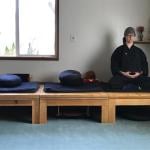In January I wrote a bit about an adventure in Pāli memorization that I have embarked upon, learning short passages by rote and then digging into their meaning. One of the more obvious starting points was the “Questions for a young monk.” This method of basic memorization and then progressively learning deeper and deeper meanings behind the words is historically how most Buddhists (monastics) have come to know the Dharma.
The questions for a young monk also make up another traditional method of learning: lists. The ten questions comprise a list of ten things, presumably ten things that anyone new to the Dharma should become acquainted with. Number seven on the list is satta bojjhaṅgā, the seven (satta) factors (aṅgā) of wisdom – or, more commonly, awakening (bojjha / bodhi).
The seven are:
- sati,
- dhamma-vicaya,
- viriya,
- pīti,
- passaddhi,
- samādhi,
- upekhā
or
- mindfulness,
- investigation of the truth,
- energy,
- joy,
- calm,
- concentration and
- equanimity
Co-arising with this mindfulness is a quality of the mind, an investigation of things as they truly are. Too much investigation (as we tend to have in the West) and anxiety arises. So this, like the others, can be taken to an extreme. The driving energy for the mind comes from the (subtle) body in the form of energy. It is this energy that give the mind and body its lightness, its ability to move freely through its investigations.
Joy is both a result of energetic investigation and a contributing factor, pushing further effort and discovery. But it too needs tempering through the power of tranquil calming. When joy gets out of hand, which is understandably easy to have happen, we lose sight of what we’re doing. Simply by sitting, we create a stability that keeps us grounded in our joy.
Concentration, or, as John translates it, ‘collection’ also serves to stabilize us in our experience, be it positive or negative, pleasant or unpleasant. And the third of what John calls the stabilizing factors is equanimity. Equanimity is our ability to hold more, an expansion to hold more suffering or more joy (one thinks of the Buddha’s analogy of putting a pinch of salt in a glass of drinking water vs a pinch of salt into the Ganges, the larger the vessel, the less it is effected by such disturbances).
That’s it.
Seven simple things to learn with the mind and realize with the body. Much like a juggling act, it will take much time and practice to get all seven in the air at once, in harmony. But when you do, there is a felt ‘break’ from the ‘sticky’ attachment with the mundane labeling mind and all of its false constructs.
After his talk, to combat my own monkey-mind, I practiced repeating the list one by one with each breath. It occurred to me at some point that we could practice them in reverse as well. Starting with a sort of ‘felt understanding’ of what awakening is, and stepping back to equanimity, back concentration, and so on until we’ve stepped ‘back’ all the way to this moment, simple awareness. Perhaps then we go forward again; first the analytic breakdown of awakening in the mind, then the synthetic construction of that awakening in one’s person. Something to work on.
See John Travis on YouTube:











